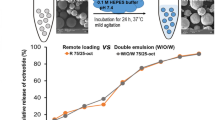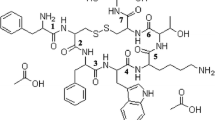Abstract
Purpose
To test the potential of water-soluble divalent cationic salts to inhibit acylation of octreotide encapsulated in poly(D,L-lactic-co-glycolic acid)-star (PLGA) microspheres.
Methods
The divalent cationic salts, calcium chloride and manganese chloride, previously shown to disrupt peptide sorption, were introduced in PLGA microspheres prepared by the double emulsion-solvent evaporation method. Peptide stability was monitored by reversed-phase high performance liquid chromatography (RP-HPLC) and identified by liquid chromatography coupled with mass spectrometry (LC-MS) during microsphere degradation under physiological conditions for 4 weeks. Microsphere morphology and salt content were examined by scanning electron microscopy (SEM) and inductively coupled plasma-optical emission spectroscopy (ICP-OES), respectively.
Results
Addition of divalent cationic salts solely to the organic phase did not provide acylation inhibition. However, addition of the salt inhibitors to both the primary emulsion and the outer water phase resulted in improved drug and salt encapsulation efficiency as well as significantly decreased salt leaching and octreotide acylation. After 28 days, the extent of acylation inhibition afforded by divalent cations was > 58% relative to 13% for the NaCl control group.
Conclusions
Water-soluble divalent cationic salts represent a suitable class of stabilizer of peptide acylation in PLGA microspheres and this study provides an important formulation approach to maximize stabilizer potency.





Similar content being viewed by others
REFERENCES
Jain RA. The manufacturing techniques of various drug loaded biodegradable poly(lactide-co-glycolide) (PLGA) devices. Biomaterials. 2000;21:2475–90. doi:10.1016/S0142-9612(00)00115-0.
Schwendeman SP. Recent advances in the stabilization of proteins encapsulated in injectable PLGA delivery systems. Crit Rev Ther Drug Carrier Syst. 2002;19:73–98. doi:10.1615/CritRevTherDrugCarrierSyst.v19.i1.20.
Jiang WL, Schwendeman SP. Stabilization and controlled release of bovine serum albumin encapsulated in poly(D, L-lactide) and poly(ethylene glycol) microsphere blends. Pharm Res. 2001;18:878–85. doi:10.1023/A:1011009117586.
Zhu GZ, Schwendeman SP. Stabilization of proteins encapsulated in cylindrical poly(lactide-co-glycolide) implants: mechanism of stabilization by basic additives. Pharm Res. 2000;17:351–7. doi:10.1023/A:1007513425337.
Jiang WL, Gupta RK, Deshpande MC, Schwendeman SP. Biodegradable poly(lactic-co-glycolic acid) microparticles for injectable delivery of vaccine antigens. Adv Drug Deliver Rev. 2005;57:391–410. doi:10.1016/j.addr.2004.09.003.
Fu K, Klibanov AM, Langer R. Protein stability in controlled-release systems. Nat Biotechnol. 2000;18:24–5. doi:10.1038/71875.
van de Weert M, Hennink WE, Jiskoot W. Protein instability in poly(lactic-co-glycolic acid) microparticles. Pharm Res. 2000;17:1159–67. doi:10.1023/A:1026498209874.
Houchin ML, Topp EM. Chemical degradation of peptides and proteins in PLGA: a review of reactions and mechanisms. J Pharm Sci. 2008;97:2395–404. doi:10.1002/jps.21176.
Estey T, Kang J, Schwendeman SP, Carpenter JF. BSA degradation under acidic conditions: a model for protein instability during release from PLGA delivery systems. J Pharm Sci. 2006;95:1626–39. doi:10.1002/jps.20625.
Kang JC, Schwendeman SP. Comparison of the effects of Mg(OH)2 and sucrose on the stability of bovine serum albumin encapsulated in injectable poly(D, L-lactide-co-glycolide) implants. Biomaterials. 2002;23:239–45. doi:10.1016/S0142-9612(01)00101-6.
Liu WR, Langer R, Klibanov AM. Moisture-induced aggregation of lyophilized proteins in the solid-state. Biotechnol Bioeng. 1991;37:177–84. doi:10.1002/bit.260370210.
Schwendeman SP, Costantino HR, Gupta RK, Siber GR, Klibanov AM, Langer R. Stabilization of tetanus and diphtheria toxoids against moisture-induced aggregation. Proc Natl Acad Sci USA. 1995;92:11234–8. doi:10.1073/pnas.92.24.11234.
Crotts G, Sah H, Park TG. Adsorption determines in-vitro protein release rate from biodegradable microspheres: quantitative analysis of surface area during degradation. J Control Release. 1997;47:101–11. doi:10.1016/S0168-3659(96)01624-0.
Calis S, Jeyanthi R, Tsai T, Mehta RC, DeLuca PP. Adsorption of salmon-calcitonin to PLGA microspheres. Pharm Res. 1995;12:1072–6. doi:10.1023/A:1016278902839.
Oscarsson S. Factors affecting protein interaction at sorbent interfaces. J Chromatogr B. 1997;699:117–31. doi:10.1016/S0378-4347(97)00224-7.
Welzel PB. Investigation of adsorption-induced structural changes of proteins at solid/liquid interfaces by differential scanning calorimetry. Thermochim Acta. 2002;382:175–88. doi:10.1016/S0040-6031(01)00728-6.
Na DH, Youn YS, Lee SD, Son MW, Kim WB, DeLuca PP, et al. Monitoring of peptide acylation inside degrading PLGA microspheres by capillary electrophoresis and MALDI-TOF mass spectrometry. J Control Release. 2003;92:291–9. doi:10.1016/S0168-3659(03)00366-3.
Murase S, Yumoto N, Petukhov MG, Yoshikawa S. Acylation of the alpha-amino group in neuropeptide Y(12–36) increases binding affinity for the Y-2 receptor. J Biochem. 1996;119:37–41.
Lucke A, Kiermaier J, Gopferich A. Peptide acylation by poly(alpha-hydroxy esters). Pharm Res. 2002;19:175–81. doi:10.1023/A:1014272816454.
Lucke A, Gopferich A. Acylation of peptides by lactic acid solutions. Eur J Pharm Biopharm. 2003;55:27–33. doi:10.1016/S0939-6411(02)00138-8.
Murty SB, Goodman J, Thanoo BC, DeLuca PP. Identification of chemically modified peptide from poly(d,l-lactide-co-glycolide) microspheres under in vitro release conditions. AAPS PharmSciTech. 2003;4:392–405. doi:10.1208/pt040450.
Lucke A, Fustella E, Tessmar J, Gazzaniga A, Gopferich A. The effect of poly(ethylene glycol)-poly(D, L-lactic acid) diblock copolymers on peptide acylation. J Control Release. 2002;80:157–68. doi:10.1016/S0168-3659(02)00020-2.
Na DH, DeLuca PP. PEGylation of octreotide: I. Separation of positional isomers and stability against acylation by Poly(D,L-lactide-co-glycolide). Pharm Res. 2005;22:736–42. doi:10.1007/s11095-005-2589-4.
Szilagyi A, Shrier I. Systematic review: the use of somatostatin or octreotide in refractory diarrhoea. Aliment Pharmacol Ther. 2001;15:1889–97. doi:10.1046/j.1365-2036.2001.01114.x.
McKeage K, Cheer S, Wagstaff AJ. Octreotide long-acting release (LAR)—a review of its use in the management of acromegaly. Drugs. 2003;63:2473–99. doi:10.2165/00003495-200363220-00014.
Houchin ML, Heppert K, Topp EM. Deamidation, acylation and proteolysis of a model peptide in PLGA films. J Control Release. 2006;112:111–9. doi:10.1016/j.jconrel.2006.01.018.
Houchin ML, Neuenswander SA, Topp EM. Effect of excipients on PLGA film degradation and the stability of an incorporated peptide. J Control Release. 2007;117:413–20. doi:10.1016/j.jconrel.2006.11.023.
Sophocleous AM, Zhang Y, Schwendeman SP. A new class of inhibitors of peptide sorption and acylation in PLGA. J Control Release. 2009. doi:10.1016/j.jconrel.2009.03.006.
Wang J, Wang BM, Schwendeman SP. Mechanistic evaluation of the glucose-induced reduction in initial burst release of octreotide acetate from poly(D, L-lactide-co-glycolide) microspheres. Biomaterials. 2004;25:1919–27. doi:10.1016/j.biomaterials.2003.08.019.
Domb AJ, Turovsky L, Nudelman R. Chemical interactions between drugs containing reactive amines with hydrolyzable insoluble biopolymers in aqueous-solutions. Pharm Res. 1994;11:865–8. doi:10.1023/A:1018985909777.
Ravivarapu HB, Lee H, DeLuca PP. Enhancing initial release of peptide from poly(d, l-lactide-co-glycolide) (PLGA) microspheres by addition of a porosigen and increasing drug load. Pharm Dev Technol. 2000;5:287–96. doi:10.1081/PDT-100100543.
Zhu GZ, Mallery SR, Schwendeman SP. Stabilization of proteins encapsulated in injectable poly (lactide-co-glycolide). Nat Biotechnol. 2000;18:52–7. doi:10.1038/71916.
Lai MC, Hageman MJ, Schowen RL, Borchardt RT, Laird BB, Topp EM. Chemical stability of peptides in polymers. 2. Discriminating between solvent and plasticizing effects of water on peptide deamidation in poly(vinylpyrrolidone). J Pharm Sci. 1999;88:1081–9. doi:10.1021/js9802289.
Lai MC, Hageman MJ, Schowen RL, Borchardt RT, Topp EM. Chemical stability of peptides in polymers. 1. Effect of water on peptide deamidation in poly(vinyl alcohol) and poly(vinyl pyrrolidone) matrixes. J Pharm Sci. 1999;88:1073–80. doi:10.1021/js980227g.
Ibrahim MA, Ismail A, Fetouh MI, Gopferich A. Stability of insulin during the erosion of poly(lactic acid) and poly(lactic-co-glycolic acid) microspheres. J Control Release. 2005;106:241–52. doi:10.1016/j.jconrel.2005.02.025.
Wang J, Wang BA, Schwendeman SP. Characterization of the initial burst release of a model peptide from poly(D, L-lactide-co-glycolide) microspheres. J Control Release. 2002;82:289–307. doi:10.1016/S0168-3659(02)00137-2.
Pistel KF, Kissel T. Effects of salt addition on the microencapsulation of proteins using W/O/W double emulsion technique. J Microencapsul. 2000;17:467–83. doi:10.1080/026520400405723.
Jiang G, Thanoo BC, DeLuca PP. Effect of osmotic pressure in the solvent extraction phase on BSA release profile from PLGA microspheres. Pharm Dev Technol. 2002;7:391–9. doi:10.1081/PDT-120015040.
De Rosa G, Quaglia F, Bochot A, Ungaro F, Fattal E. Long-term release and improved intracellular penetration of oligonucleotide-polyethylenimine complexes entrapped in biodegradable microspheres. Biomacromolecules. 2003;4:529–36. doi:10.1021/bm025684c.
Herrmann J, Bodmeier R. The effect of particle microstructure on the somatostatin release from Poly(Lactide) microspheres prepared by a W/O/W solvent evaporation method. J Control Release. 1995;36:63–71. doi:10.1016/0168-3659(95)00051-9.
Fredenberg S, Reslow M, Axelsson A. Effect of divalent cations on pore formation and degradation of Poly(D, L-lactide-co-glycolide). Pharm Dev Technol. 2007;12:563–72. doi:10.1080/10837450701560588.
ACKNOWLEGMENTS
This study was supported by Novartis Pharma AG and NIH HL 68345.
Author information
Authors and Affiliations
Corresponding author
Rights and permissions
About this article
Cite this article
Zhang, Y., Sophocleous, A.M. & Schwendeman, S.P. Inhibition of Peptide Acylation in PLGA Microspheres with Water-soluble Divalent Cationic Salts. Pharm Res 26, 1986–1994 (2009). https://doi.org/10.1007/s11095-009-9914-2
Received:
Accepted:
Published:
Issue Date:
DOI: https://doi.org/10.1007/s11095-009-9914-2




